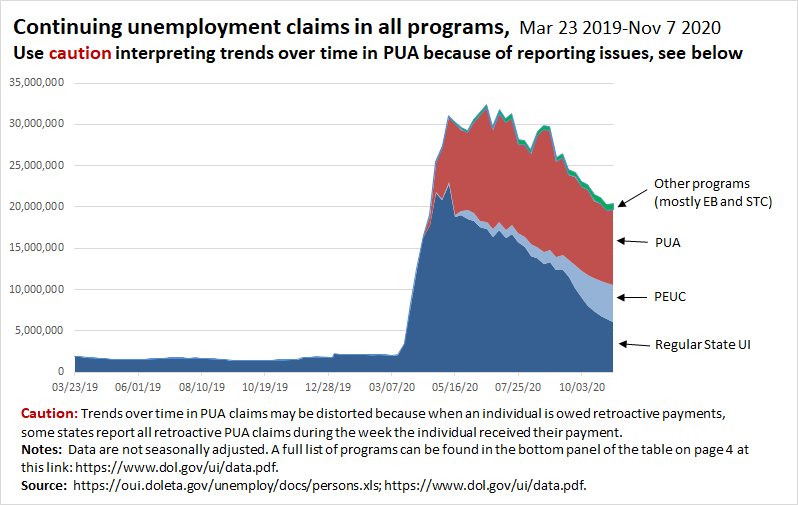
Plot twist! Unemployment Insurance claims are being released today, *Wednesday*. Here we go. 0/
Another 1.1 million people applied for UI last week, including 778,000 people who applied for regular state UI and 312,000 who applied for Pandemic Unemployment Assistance (PUA). 1/ dol.gov/ui/data.pdf
The 1.1 million who applied for UI last week was an increase of 22,000 from the prior week’s figures. This is the second week in a row of increases in initial claims. Not good. 2/
Last week was the 36th straight week total initial claims were greater than the worst week of the Great Recession (GR). If you restrict to regular state claims (b/c we didn’t have PUA in the GR), initial claims are higher than the second highest week of the GR. 3/
Most states provide 26 weeks of regular benefits, and this crisis has gone on much longer than that, which means many workers are exhausting their regular state UI benefits. In the most recent data, continuing claims for regular state UI dropped by 299,000. 4/
For now, after an individual exhausts regular state benefits, they can move onto Pandemic Emergency Unemployment Compensation (PEUC), which is an additional 13 weeks of regular state UI. But PEUC expires on December 26. More on that later. 5/
In the latest data available for PEUC, the week ending Nov 7, PEUC rose by just 132,000, offsetting less than a third of the 414,000 decline in continuing claims for regular state benefits for the same week. 6/
Why didn’t PEUC rise more? Many of the roughly 2 million people who were on UI before the recession began, or who are in states w/ less than 26 weeks of regular state benefits, are now *exhausting* PEUC. More than 1.5 million workers have exhausted PEUC so far. 7/
In some states, if workers exhaust PEUC, they can get on yet another program, Extended Benefits (EB). In the latest data, 601,000 workers were on EB. That’s far less than half of those who have exhausted PEUC. Most are left with nothing. 8/
This chart shows continuing claims in all programs over time (the latest data for this are for Nov 7). The total number of workers on UI ticked *up* in the latest data, even with the exhaustions we've seen so far. This is a wake up call. 9/ 

Republicans in the Senate allowed the across-the-board $600 increase in weekly UI benefits to expire at the end of July. Last week was the 17th week of unemployment in this pandemic for which recipients did not receive the extra payment. 10/
And w/o congressional action, PUA & PEUC will expire on Dec 26. Millions of workers are depending on these programs (DOL reports 13.7 mil for the week ending Nov 7). When they expire, millions of these workers & their families will be financially devastated. 11/
@pelhamprog and @ENPancotti find that 12 million workers will lose PUA or PEUC benefits when they expire on Dec 26—on top of the 4.4 million who will have exhausted them before then. And only 2.9 million will then be eligible for EB. 12/
https://twitter.com/ENPancotti/status/1329047409691930624
That means a total of 13.5 million workers (12.0 million + 4.4 million – 2.9 million) will have lost CARES Act benefits by the end of the year with nothing to fill in the gap. 13/
The House passed a $2.2 trillion relief package, but McConnell has thus far blocked additional COVID relief—knowing full well that millions will see their benefits disappear on Dec 26 if he doesn’t act. The cruelty is beyond belief. 14/
And blocking COVID relief is not just cruel, it’s terrible economic policy. UI is great stimulus. The spending made possible by pandemic UI benefits is supporting millions of jobs. Letting these benefits expire means cutting those jobs. 15/
There are now 25.7 million workers who are officially unemployed, otherwise out of work because of the virus, or have seen a drop in hours and pay because of the pandemic. And job growth is slowing. Stimulus is desperately needed. 16/ epi.org/blog/what-the-…
Blocking stimulus is also exacerbating racial inequality. Due to the impact of historic & current systemic racism, Black and Latinx workers have seen more job loss in this pandemic, and have less wealth to fall back on. Stimulus is a racial justice issue. 17/
And this is your regular reminder that people haven’t just lost their jobs. Millions of workers and their family members have lost employer-provided health insurance due to the coronavirus downturn. 18/
And as always, here's this tweet thread in a blog post. n/ epi.org/blog/unemploym…
• • •
Missing some Tweet in this thread? You can try to
force a refresh


